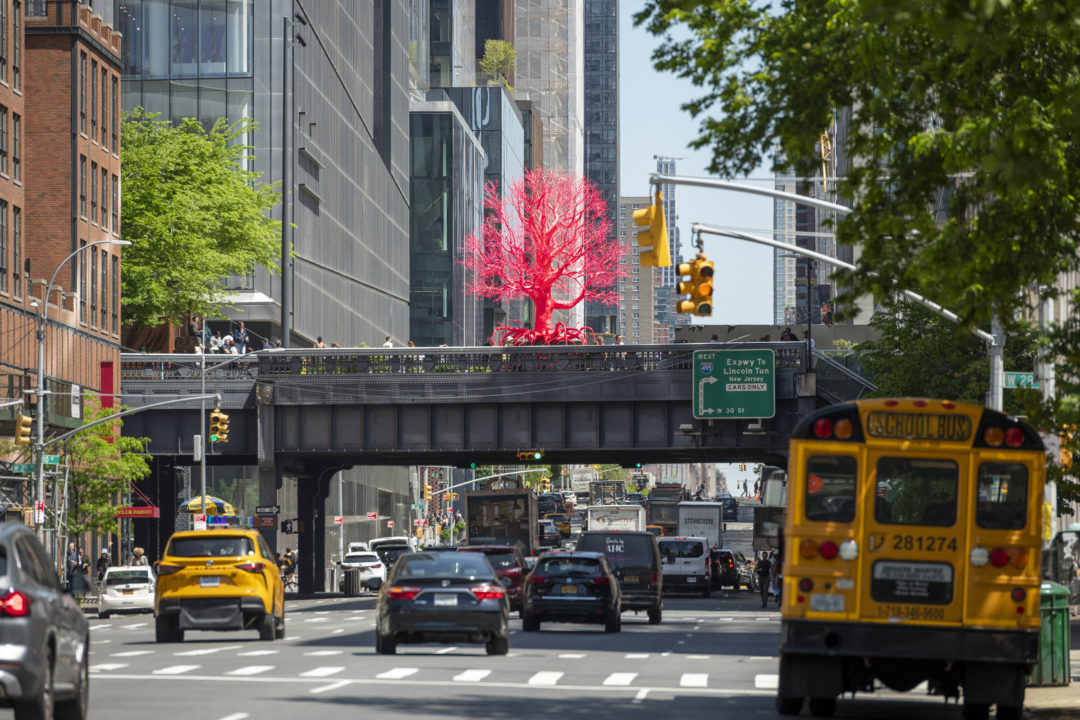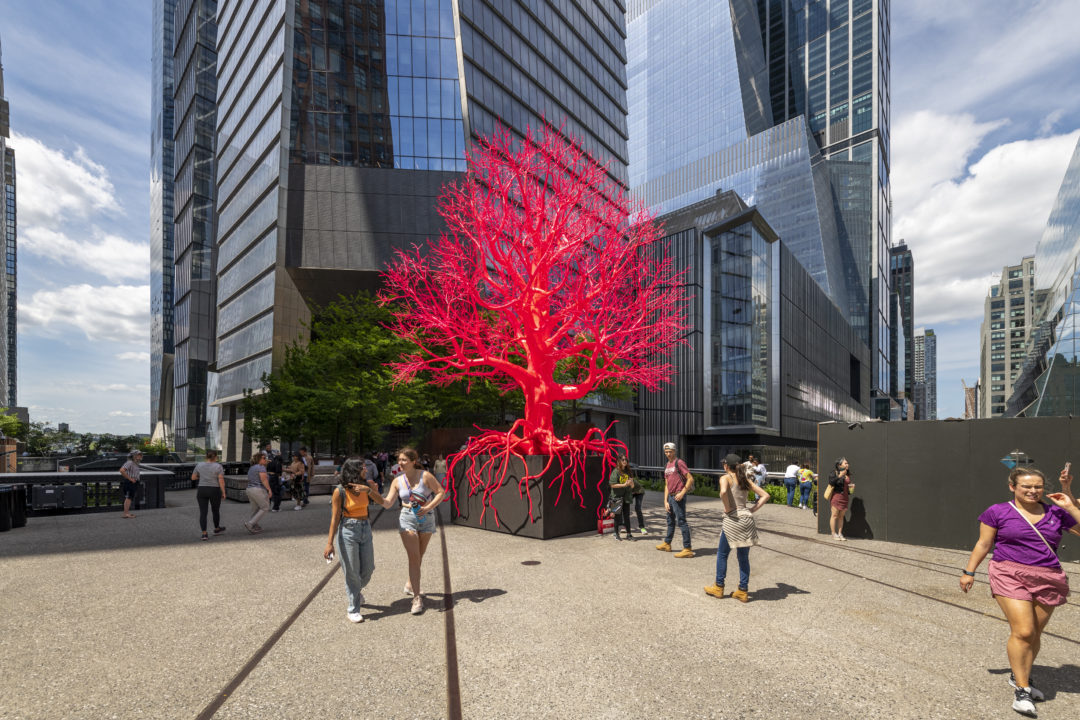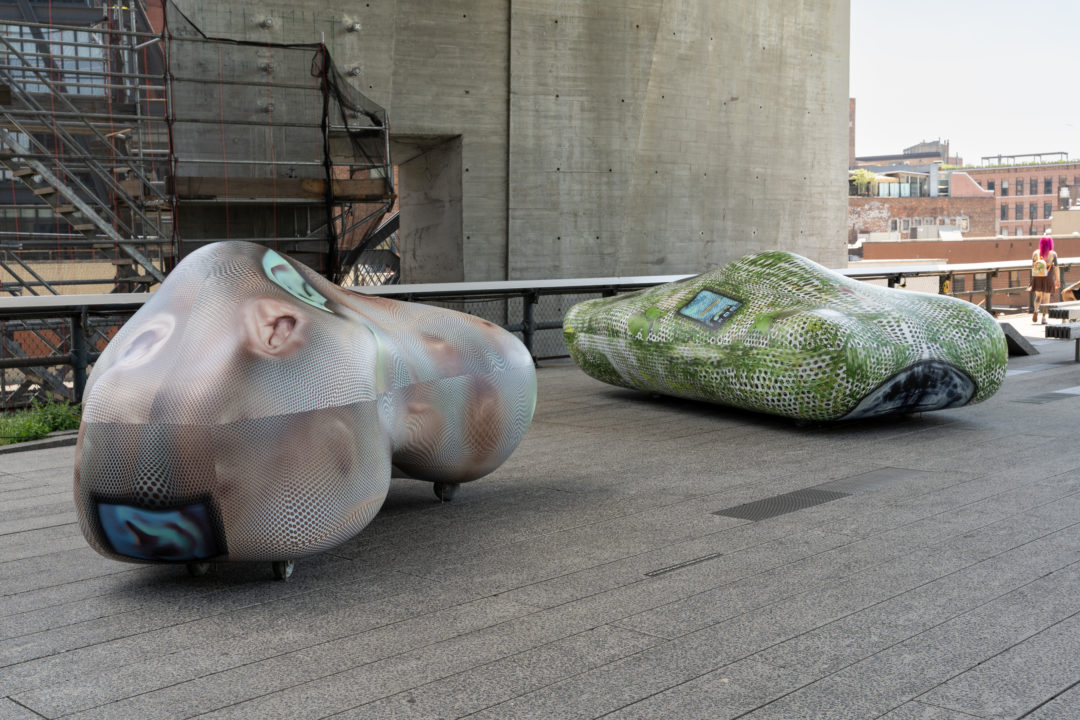On the High Line

On the High Line, New York City:
Commissioned works of Tishan Hsu and Pamela Rosenkrantz
A pharmakon is defined as a drug that can act as a remedy or poison. Nothing could be more true about some sculptural works that currently inhabit the High Line, Pamela Rosenkrantz’s Old Tree (2023) and Tishan Hsu’s car-grass-screen-2 and car-body-screen-2 (2024).Amidst the beauty of the naturally landscaped design of the High Line, with its arboreal and floral splendor, sit these powerful political works that reflect upon the program of the Enlightenment as well as questioning what is truly “artificial” or “natural.” The contrast is unmistakable. Both spark post-humanist reflections in which a white, Eurocentric normative male vision has been challenged and displaced to make room for other voices, feminist and multispecies, with which to care for nature and manage our planet; in the case of Rosenkrantz, the extinction of nature resulting from what is called the Anthropocene and, in the case of Hsu, multispecies embodiment, the production of a cyborg aesthetic and the power of the state.

Photo: Timothy Schenck
Pamela Rosencranz’s Old Tree is an alien presence situated on the section of the Highline called the Spur at 10th Avenue and 30th Street. Itis a vibrant bright red, steel and epoxy sculpture of a tree woven into the tapestry of the urban jungle, with all of its fractured sensations, exoticism and confusion that surrounds it. Below, a cacophony of honking horns of moving cars, and above, a jungle of tall glass and steel skyscrapers that are a testament to the International Style. The work stands twenty-five feet atop of the High Line and consists of 125 leafless branches that resemble both the limbs of a tree and human blood vessels. Old Tree emerges from a black powder coated minimalist cube which supports it and around which the artificial root system is wrapped, clinging for dear life. It is a tree that lacks a crown of foliage made of up leaves necessary for photosynthesis and the oxygenation of our atmosphere for which we depend for our life sustenance. Sap does not run through its ribs and veins and it provides little shade beyond a meager silhouette. Rather, it stands contrapposto in a state of petrified absence.
Make no mistake about it, Old Tree is a magnificent subversive political work of art that illustrates not only the tree of life, as some critics have stated in the many reviews that have accompanied the work, but the tree of death – an alienated nature at the hands of a form of capitalism without a heart which knows no limit and respects nature only in relation to corporate greed resulting in the extinction of countless species of plants and animals as well as leaving a contaminated trail of dangerous elements, like cadmium, arsenic, lead, and mercury, in the critical zone of the earth’s crust. Although the work appears to be a poster child for nature’s bounty and renewal, it is rather a provocative statement of what Paul J. Crutzen calls the Anthropocene, a geological epoch in which humanity’s negative role in the transformation of the earth and atmosphere has led to the imminent planetary catastrophe. Old Tree is a tribute to the Anthropocene and its personification.

Photo: Timothy Schenck
No indication is better correlated with the destruction of the global biosphere and ambience than the accumulation of carbon dioxide (CO2), which is directly correlated to the consumption of fossil fuels and forest fires generated to clear land for agriculture and housing. A recent account in The Guardian, entitled “Amazon rainforest now emitting more CO2 than it absorbs,” has suggested that while in the past the Amazonian rain forest mitigated C02, today, because of habitat destruction and burning, it is accelerating climate change. Old Tree is a beacon that attracts the public with its beauty and aesthetic appeal but its scope needs to be widened by public programing so that it also can be a site for the contemplation of the effects of the Anthropocene. It should become a place where members of our community gather and discuss deep ecological solutions that understands that nature has its own inherent value other than its usefulness to humanity.

Tishan Hsu’s multimedia sculptures, car-grass-screen-2 and car-body-screen-2, proposes a transhumanist model that interrogates and questions the assumption that the human race can evolve beyond its physical and mental limitations with the help of technology. Located on the High Line some 1.7 miles from Old Tree at Little West 12th street, car-grass-screen-2 and car-body-screen-2 rests in the shadow of the Whitney Museum. Appearing as two biomorphic organic shapes that remind one of cars, they are wrapped and transformed by a resin-coated foam carapace. Like Old Tree, it too is a political work that evokes both optimism and pessimism simultaneously at play in our technologically inflected world. Hsu uses unusual fabrication techniques like 3D and UV printing to portray a hybrid existence at the human-technological interface. Included in the sculpture’s “screen skins” are scannable QR codes and video screens interlaced amidst UV printed perforated fabric which stream strange hybrid and multispecies orifices that pulsate with quiet menace. The screens also provide portals into the virtual, expanding the work’s presence beyond the limits of the real. The work interrogates the cyborg defined as a hybrid of machine and organism that populate the world as both natural and crafted chimeras. The cyborg, according to Donna Haraway’s A Cyborg Manifesto (1985), is a creature in a post-gendered world and, as such, offers succor for feminist aspirations of equality but also simultaneously reminds us of the cyborgs origins as illegitimate offspring of militarism and patriarchal capitalism, as well as state socialism. With any interactive human-internet activation comes the possibility of data mining and surveillance.
Together both of these works use the artistic tools, apparatuses, programs and materials to probe our technological futures simultaneously provoking amazement for some and unease for others.

Head image : Tishan Hsu, car-grass-screen-2 & car-body-screen-2, 2024. Graphiques imprimés en résine, en mousse, en acier et en vinyle / Resin, foam, steel, and vinyl printed graphics.
- From the issue: 109
- Share: ,
- By the same author: Not Everything is Given, Whitney ISP, New York,
Related articles
Ralph Lemon
by Caroline Ferreira
Ho Tzu Nyen
by Gabriela Anco
Hilma af Klint
by Patrice Joly

